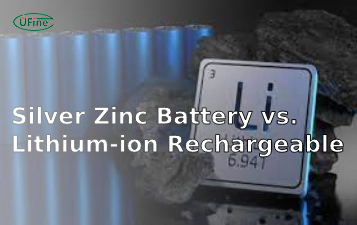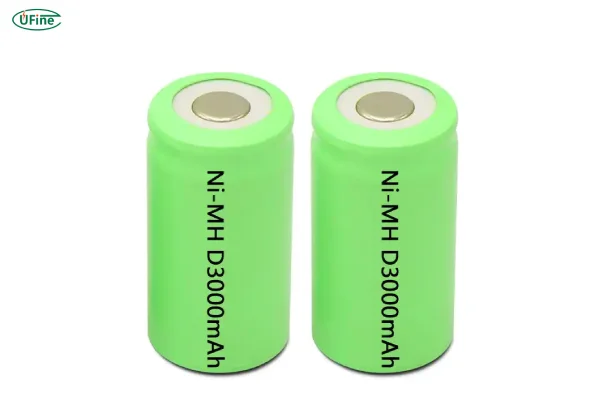
Part 1. Understanding NiMH batteries
Before diving into the specific characteristics of the Size D NiMH battery, it’s essential to understand what a NiMH battery is. NiMH stands for Nickel-Metal Hydride, a rechargeable battery technology that has become increasingly popular due to its eco-friendly design, cost-effectiveness, and reliable performance.
NiMH batteries use a nickel oxyhydroxide compound for the positive electrode and a hydrogen-absorbing alloy for the negative electrode. These batteries stand out for their higher energy density compared to older technologies like Nickel-Cadmium (NiCd) and alkaline batteries. As a result, NiMH batteries have gained popularity across multiple sectors, including household electronics, power tools, and even electric vehicles.
The Size D NiMH battery is part of the larger NiMH family, providing higher capacity and longer runtime. Whether you’re powering high-drain devices or seeking a reliable energy source for large toys or flashlights, the Size D NiMH battery is a strong contender. But, what exactly makes this battery so special, and what are its benefits over other battery technologies?
Part 2. Size
When we talk about the size of a Size D NiMH battery, we’re referring to the physical dimensions of the battery. Size D batteries are typically 61.5mm in length and 33.2mm in diameter. This makes them notably larger than other common rechargeable batteries like AA or AAA.
This larger size allows the Size D NiMH battery to store more energy. The increased capacity of the battery gives it the ability to power devices that demand extended usage. Whether you are using flashlights, radios, or power tools, the Size D NiMH battery is designed to last longer and provide sustained energy over longer periods.
However, it’s important to understand that this size also impacts the weight of the battery. While the additional weight can provide a sense of durability and longevity in some devices, it may be a concern in certain applications where lightweight is crucial.
Part 3. Voltage
One of the defining features of the Size D NiMH battery is its voltage, which is typically 1.2V. This voltage is consistent across all NiMH batteries, regardless of their size, including the AA and AAA variations. However, it’s important to understand that 1.2V is lower than the 1.5V provided by alkaline batteries.
While alkaline batteries provide a slightly higher voltage, NiMH batteries offer other advantages, such as higher capacity, rechargeability, and environmental friendliness. The 1.2V output of a Size D NiMH battery is usually sufficient to power devices that require high current, making them an excellent choice for applications where high capacity is prioritized over voltage.
Furthermore, NiMH batteries maintain a stable voltage throughout most of their discharge cycle. This helps ensure that the device they are powering performs consistently, without significant drops in power output. This is especially important for power-hungry devices like cordless drills and flashlights.
Understanding 1.2 V NiMH Battery: Key Insights
Part 4. Advantages
The Size D NiMH battery comes with several distinct advantages, which make it a preferred choice in various applications. Here are some of the most notable benefits:
1. Rechargeability
The most significant advantage of NiMH batteries, including Size D NiMH batteries, is that they are rechargeable. Unlike traditional alkaline batteries, which are single-use, NiMH batteries can be recharged up to 500 times or more. This not only reduces waste but also makes them a more cost-effective option in the long run.
2. Environmental Impact
NiMH batteries are greener than many other battery technologies. Nickel-Metal Hydride contains fewer harmful chemicals like mercury or cadmium (which are found in older NiCd batteries), making them a more environmentally friendly choice.
3. High Capacity
Size D NiMH batteries are designed to store more energy than smaller counterparts. With capacities ranging from 2,000mAh to 10,000mAh, they can provide extended runtime for high-demand devices like portable radios, power tools, and flashlights. This makes them ideal for applications that require longer operational times without needing constant replacements.
4. Stable Performance
NiMH batteries maintain a relatively stable voltage during the majority of their discharge cycle. This provides consistent power output, which is essential for devices like flashlights or radios where performance shouldn’t diminish too quickly as the battery drains.
5. Low Self-Discharge Rate
Newer models of NiMH batteries have a low self-discharge rate. This means they can hold their charge for months without a significant drop in energy, making them a great option for devices that aren’t used often but need to be ready when you need them.
Part 5. Disadvantages
While Size D NiMH batteries come with numerous advantages, they are not without their limitations:
1. Lower Voltage
As mentioned earlier, NiMH batteries provide 1.2V of voltage, which is lower than the 1.5V offered by traditional alkaline batteries. This can affect the performance of certain devices that require the higher voltage to operate optimally. For such applications, you might need to consider other battery types.
2. Memory Effect
NiMH batteries can suffer from a phenomenon known as the memory effect. If a battery is not fully discharged before being recharged, it may “remember” its shorter discharge cycle, causing it to lose its full charge capacity. However, modern low self-discharge NiMH batteries have largely addressed this issue.
3. Longer Charging Time
NiMH batteries generally take longer to recharge compared to alternatives like lithium-ion batteries. Depending on the charger and battery size, recharging a Size D NiMH battery can take several hours.
4. Heavier Weight
Due to their larger size and the materials used in their construction, Size D NiMH batteries tend to be heavier than their counterparts like AA or AAA batteries. This extra weight can be a concern in applications where lightweight is a critical factor, such as in certain portable devices.
Part 6. Applications
Size D NiMH batteries are used across a wide range of devices that require extended use and reliable performance. Some common applications include:
-
Flashlights: Size D batteries power high-performance flashlights for camping, emergency use, or industrial work. Their high capacity ensures long runtimes, even in the most demanding conditions.
-
Power Tools: Many cordless drills and other power tools rely on Size D NiMH batteries to provide the torque and sustained power required for tasks like drilling or screwing.
-
Toys: Larger remote control toys or battery-powered toys use Size D NiMH batteries because of their ability to provide long-lasting power.
-
Radios and Walkie-Talkies: Portable communication devices that need to operate for extended periods often rely on Size D NiMH batteries due to their reliability and capacity.
-
Portable Fans: In applications where a mobile power source is required, Size D NiMH batteries are often used to power portable fans.
Part 7. Capacity
The capacity of a Size D NiMH battery is typically measured in mAh (milliampere-hours). This is a key specification when choosing the right battery for your device. For Size D NiMH batteries, the capacity usually ranges between 2,000mAh to 10,000mAh, depending on the model and brand.
A higher capacity means a longer runtime, so choosing the right capacity is crucial for applications like cordless power tools or flashlights, where extended power is essential.
Part 8. Is size D NiMH battery rechargeable?
Size D NiMH batteries are rechargeable, which is one of their greatest advantages. Rechargeability allows you to use the same battery multiple times, significantly reducing waste and saving money over time. These batteries can be charged hundreds of times before their capacity begins to degrade.
To recharge a Size D NiMH battery, you’ll need a compatible NiMH charger. It’s important to use the correct charger to avoid damaging the battery or reducing its lifespan.
Part 9. What battery can replace size D NiMH battery?
If you need to replace a Size D NiMH battery, there are a few alternatives to consider:
-
Size D Alkaline Battery: An alkaline battery can temporarily replace a NiMH battery for single-use applications. However, you won’t have the advantage of rechargeability.
-
Lithium-Ion Battery: In some cases, lithium-ion batteries can replace NiMH batteries, but they may require an adapter or special considerations because Li-ion batteries typically have different voltage and capacity characteristics.
-
NiCd (Nickel-Cadmium) Battery: NiCd batteries, while less popular today due to their memory effect and environmental concerns, could also be used as a replacement in certain applications.
Related Tags:
More Articles

What is the Difference Between Silver Zinc Battery vs. Lithium-ion Rechargeable?
Compare silver zinc and lithium-ion rechargeable batteries: energy density, cycle life, safety, cost, and uses in drones, medical devices, EVs, and electronics.
What are Watts and Watt Hours in Battery?
Understand watt vs watt-hour in batteries: key differences, how to calculate capacity, and why they matter. Includes free comparison table.
Best 10 Blood Pressure Monitor Battery Review: Finding the Most Reliable
Are you looking for a reliable Blood Pressure Monitor battery? Here is a complete guide with the top 10 best blood pressure monitor batteries.
Bluetooth Headphone Battery Guide: All You Need to Know
Maximize headphone battery life with expert tips! Learn how to charge, check, troubleshoot, and choose the best bluetooth headphone battery in 2025.
LiFePO4 Battery VS. Lithium-ion Polymer Battery: Which One Is Best?
Comprehensive comparison of LiFePO4 vs Lithium Ion Polymer batteries: energy density, safety, lifespan, cost. Find out which battery suits your needs in 2025.



